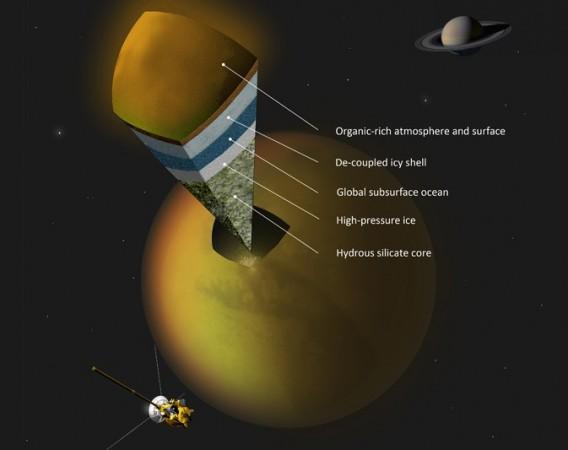
Nasa's Cassini spacecraft has revealed that Saturn's giant Moon Titan might have an ocean beneath its ice shell, said a study published in the journal Science.
According to scientists, when the Moon orbits around Saturn it gets squeezed or stretched. Nasa's Cassini spacecraft measured the gravitational effect of the squeeze and the pull and detected the solid tides caused by the Saturn's pull on Titan.
Solid tides up to 1 metre is formed on the Moon due to the gravitational attraction as Saturn is believed to have been made of solid rock material. However, the researchers noticed that solid tides were formed up to 10 metres, thus suggesting that Titan is not just made of solid rock material but may have the presence of liquid water.
"Cassini's detection of large tides on Titan leads to the almost inescapable conclusion that there is a hidden ocean at depth," Luciano Iess, the paper's lead author and a Cassini team member at the Sapienza University of Rome, said in a statement.
"The search for water is an important goal in solar system exploration, and now we've spotted another place where it is abundant," he added.
The Moon Titan orbits around the Saturn once in every 16 days, which helped the researchers to study the shape of the Moon at different parts. The shape of Titan is slightly elongated and hence its long axis grows when it comes closer to Saturn. But it looks more circular in shape when the Moon orbits far away from the planet.
The Cassini spacecraft, which made six flybys between 2006 and 2011, is built to study the gravitational effect of this squeeze and pull. Based on the data sent to NASA's Deep Space Network (DSN), researchers were able to study the internal structure of Titan, which indicated the presence of liquid water buried under the ice shell.
"We were making ultrasensitive measurements, and thankfully Cassini and the DSN were able to maintain a very stable link," Sami Asmar, a Cassini team member at NASA's Jet Propulsion Laboratory in Pasadena, California, said.
"The tides on Titan pulled up by Saturn aren't huge compared to the pull the biggest planet, Jupiter, has on some of its moons. But, short of being able to drill on Titan's surface, the gravity measurements provide the best data we have of Titan's internal structure," Asmar added.
The presence of water increases the idea of life existing in the planet, but researchers insist that the findings did not indicate the existence of microbial life.
















